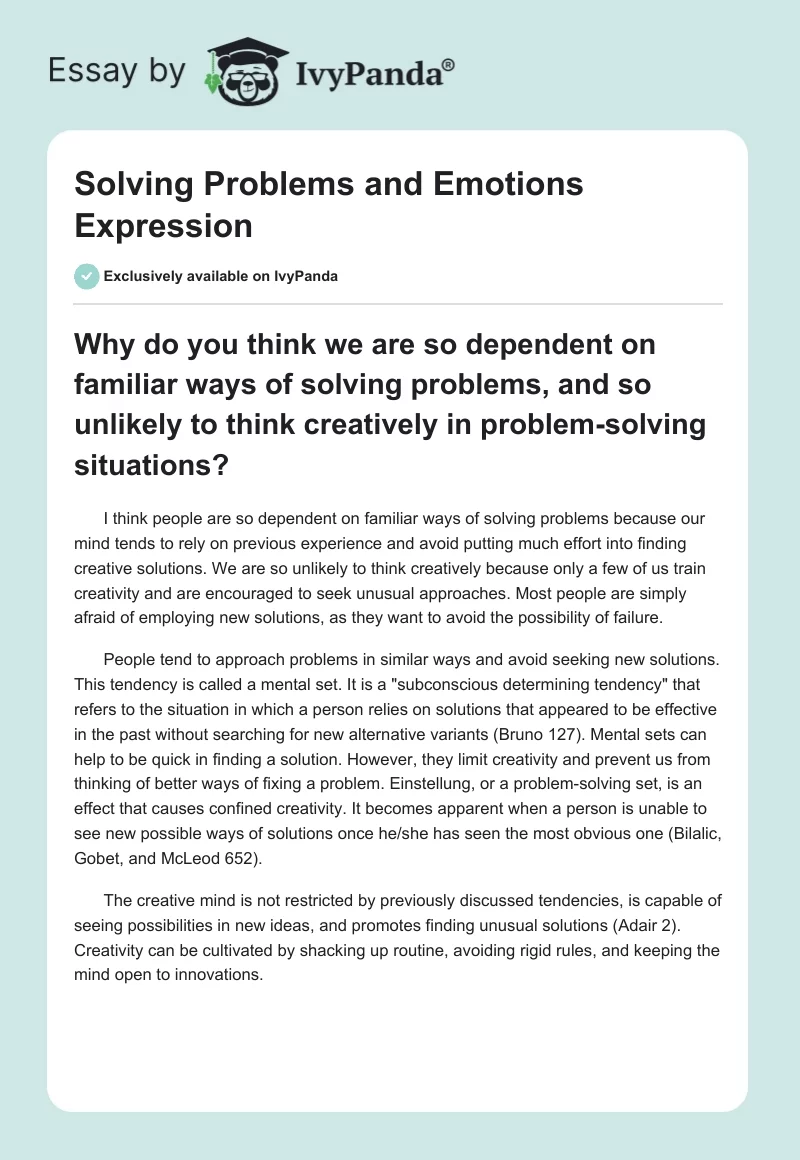Why do you think we are so dependent on familiar ways of solving problems, and so unlikely to think creatively in problem-solving situations?
I think people are so dependent on familiar ways of solving problems because our mind tends to rely on previous experience and avoid putting much effort into finding creative solutions. We are so unlikely to think creatively because only a few of us train creativity and are encouraged to seek unusual approaches. Most people are simply afraid of employing new solutions, as they want to avoid the possibility of failure.
People tend to approach problems in similar ways and avoid seeking new solutions. This tendency is called a mental set. It is a “subconscious determining tendency” that refers to the situation in which a person relies on solutions that appeared to be effective in the past without searching for new alternative variants (Bruno 127). Mental sets can help to be quick in finding a solution. However, they limit creativity and prevent us from thinking of better ways of fixing a problem. Einstellung, or a problem-solving set, is an effect that causes confined creativity. It becomes apparent when a person is unable to see new possible ways of solutions once he/she has seen the most obvious one (Bilalic, Gobet, and McLeod 652).
The creative mind is not restricted by previously discussed tendencies, is capable of seeing possibilities in new ideas, and promotes finding unusual solutions (Adair 2). Creativity can be cultivated by shacking up routine, avoiding rigid rules, and keeping the mind open to innovations.
Can you think of a real-life situation in which you were forced to “undo” some of the progress to solve a problem
I think one of the real-life situations illustrating the necessity of moving backward to solve a problem was my experience in physical training. As my goal was to get good results quickly, I started working out a lot. For some period, I had obvious results, and then the progress stopped. The fitness trainer warned me that amount of working out and the capacity of weights used in it sometimes should be reduced to give rest to the body and get better results in the future. It was difficult for me to accept such solutions, as I found moving backward from achievements disappointing. However, when I followed the advice, I saw that the progress made after moving backward was even bigger.
People tend to have a difficult time solving the type of problem where they have to move back because they are usually afraid of moving from a final goal. They are unlikely to set sub-goals and usually take the actions that seem to move them directly toward the ultimate objective. Such a strategy is called hill-climbing. The biggest disadvantage of this heuristic is the inability to see fewer directive choices that can bring the biggest long-term benefits (Medin 335). It is of vital importance to understand that some situations require moving back to find the best possible solution.
How are emotions experienced and expressed? How do emotions motivate cognitive activity and behavior?
People experience emotions while facing different life situations. We experience a wide range of emotions based on our perception of various events. Such experience occurs subconsciously, and it is rather hard to control it. The emotions can be expressed verbally and non-verbally. Non-verbal expressions include facial expressions and “emotional body language” (Gelder, Schindler, and Van Gool 1238).
Emotions motivate thinking or cognitive activity (Deckers 390). The nature of emotional affect influences and determines future cognitive appraisal. The emotional effect can also motivate the behavior that fulfills the aim of emotion (Deckers 391). People can be unaware of why they feel happy or angry, but the emotion will motivate avoidance or confrontational behavior (Deckers 391).
Works Cited
Adair, John. The Art of Creative Thinking: How to be Innovative and Develop Great Ideas, London, United Kingdom: Kogan Page Publishers, 2009. Print.
Bilalic, Merim, Fernand Gobet, and Peter McLeot. “Why Good Thoughts Block Better Ones: The Mechanism of the Pernicious Einstellung (set) Effect.” Cognition 108.3 (2008): 652-661. Print.
Bruno, Frank. Psychology: A Self-Teaching Guide, New York: John Wiley & Sons, 2002. Print.
Deckers, Lambert. Motivation: Biological, Psychological, and Environmental. 4th ed. 2015. New York: Routledge. Print.
Gelder, Beatrice, Konrad Schindler, and Luc Van Gool. “Recognizing Emotions Expressed by Body Pose: A Biologically Inspired Neural Model.” Neural Networks 21.9 (2008): 1238–1246. Print.
Medin, Douglas. Stevens’ Handbook of Experimental Psychology, Memory and Cognitive Processes, New York: John Wiley & Sons, 2002. Print.


